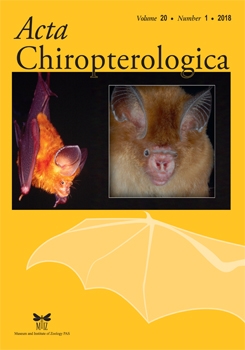The brown planthopper (Nilaparvata lugens) is one of the major insect pests of rice fields in Southeast Asia. They have been widely acknowledged for causing significant rice yield losses. However, the wrinkle-lipped free-tailed bat (Chaerephon plicatus Buchannan, 1800) is a known agent of pest suppression for white-backed planthoppers (Sogatella furcifera), and may also suppress brown planthopper populations. Hence, it is important to investigate the diet of C. plicatus in areas where brown planthoppers are common to determine whether these bats feed on these insects. To accomplish this objective, we analyzed the diet of C. plicatus from two caves that differed in the percentage of surrounding land area occupied by rice fields (70% versus 22%). Bat fecal pellets were collected monthly for a year. A total of 720 fecal pellets were analyzed, and the results revealed that C. plicatus feeds on at least eight insect orders, including Coleoptera, Homoptera, Hemiptera, Diptera, Lepidoptera, Odonata, Hymenoptera and Orthoptera. Specifically, homopterans comprised the greatest diet volume in the rice growing season, whereas coleopterans were most abundant in the diet when rice fields were fallow. Moreover, most homopterans were identified as brown planthoppers. To estimate the relative numbers of brown planthoppers consumed during each month, the number of genitalia of male brown planthoppers was counted. We recorded the greatest numbers of genitalia during the rice planting period, with an average of four genitalia per fecal pellet. Examining both the percent volume and percent frequency of each insect order in the diet of C. plicatus revealed that the two study caves were no significantly different, even though the proportion of surrounding active rice fields was different. Our results suggest that tens of millions of brown planthoppers are consumed by this bat species each night. The similar diets of the two study colonies may be due to their high altitude foraging and preference for migratory insects. Our results indicate that the wrinkle-lipped freetailed bat is an important biological suppression agent of brown planthoppers in rice fields.
How to translate text using browser tools
1 June 2018
The Wrinkle-Lipped Free-Tailed Bat (Chaerephon plicatus Buchannan, 1800) Feeds Mainly on Brown Planthoppers in Rice Fields of Central Thailand
Supawan Srilopan,
Sara Bumrungsri,
Sopark Jantarit
ACCESS THE FULL ARTICLE

Acta Chiropterologica
Vol. 20 • No. 1
June 2018
Vol. 20 • No. 1
June 2018
biological pest suppression
diet
economic pest
high altitude foraging
Homoptera
insectivory
percent frequency




